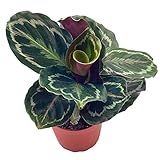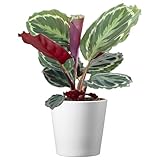With its large, emerald leaves with contrasting white stripes and burgundy underneath, Calathea Medallion is one of the most beautiful houseplants. Calathea veitchiana has such a graceful appearance that it’s easy to see why it is becoming more and more popular among gardeners from all over the world.
Part of the prayer-plant family Marantaceae, Calatheas have an incredible ability: they move their leaves in accordance to the day-night circadian rhythm. At nighttime, you will notice the leaves folding up as if in prayer, hence the nickname. Native to the tropical Americas, Calatheas are the definition of greenhouse plants, so creating the right environments is essential for their survival.
Besides adding interest to any dull corner, this tropical plant has another perk: it thrives in low-light conditions. However, caring for Calathea Medallion requires more dedication than regular indoor plants do. Although we do not discourage inexperienced gardeners to get one, we strongly advise them to consider its care requirements before deciding to add a Calathea Medallion to their collection of plants.
But don’t worry, by the end of this article you will find out everything you need to know about growing Calathea veitchiana ‘Medallion’.
Watch Our Latest YouTube Video ...
Quick Facts
| Fact Category | Details |
|---|---|
| Scientific Name | Calathea veitchiana |
| Common Appearance | Large, emerald leaves with white stripes and burgundy underside |
| Unique Ability | Moves leaves according to the day-night circadian rhythm |
| Origin | Tropical Americas |
| Light Requirements | Thrives in low-light conditions; prefers indirect sunlight |
| Toxicity | Non-toxic to animals and humans |
| Care Level | Requires more dedication than regular indoor plants |
| Height (when mature) | 2 to 3 feet (60 to 90 cm) |
| Temperature Range | 65° to 80° Fahrenheit (18° to 29° Celsius) |
| Soil Requirements | Porous potting mix with excellent drainage (potting soil, peat moss, perlite, etc.) |
| Watering Frequency | Regularly, based on soil moisture |
| Propagation Method | By dividing roots before the growing season |
| Economic Importance | Leaves used for food wrapping and handicrafts in native regions; source of income for locals |
| Threat Status | Some species are threatened due to habitat loss |
| Special Note | Calatheas move their leaves by changing water pressure in their pulvini nodes |
About Calathea Medallion
- Calathea Medallion is non-toxic to animals or humans, so you can rest assured that your family is safe around this plant. However, it is said that Calatheas are tasty, so you might want to keep them away from curious pets.
- There are hundreds of different types of Calathea. Calathea veitchiana ‘Medallion’(Medallion calathea), Calathea ornata (Pinstripe calathea), Calathea roseopicta ‘Dottie’ (Calathea Dottie), and Calathea lancifolia (Rattlesnake calathea) are some of the most popular species.
- In its native range, Calathea leaves are used for food wrapping and handicraft. In parts of Brazil, they are used to wrap fish before transport and for weaving baskets. In Colombia, containers are made out of large, tough Calathea leaves. Nevertheless, the most famous handicraft items are the rice containers produced in the villages of Thailand.
- Unfortunately, several species are threatened with extinction due to habitat loss. This can have a huge economic impact, as Calathea leaves are an important source of income for locals.
- As long as the temperature is right, Calathea Medallion can be grown in outdoor condition. It would make a beautiful addition to a deck or porch.
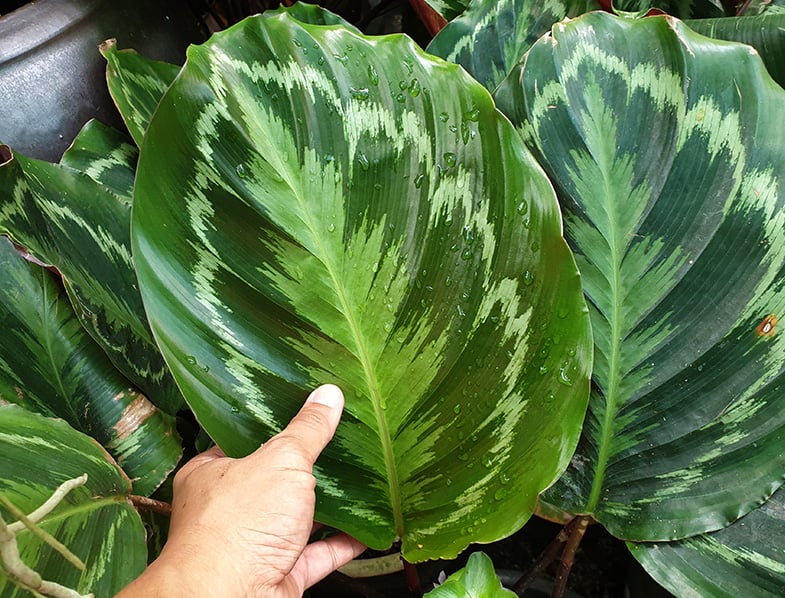
Calathea Medallion Features: An Overview
- Calatheas are popular due to their colourful inflorescences and large, decorative leaves. In their natural environment, their leaves provide habitat for many invertebrates, as they can retain pools of water (phytotelmata).
- Calathea plants fold up their leaves during the night, revealing the colourful undersides of their stunning leaves. This process is called nyctinasty.
- Calathea Medallion moves its leaves by changing the water pressure in the swollen pulvini nodes (joints) located at the base of the leaf along the petiole. It is believed the plant does this to follow the sun’s movement and maximize light absorption.
- Unlike specimens that grow in the wild, indoor Calathea veitchiana plants will never flower, so they don’t generate any scent. This can be an advantage for gardeners who suffer from hay fever.
- The absence of flowers isn’t a concern, as the plant’s foliage makes a bold statement alone.
- Fully mature Medallions can get about 2 to 3 feet (60 to 90 cm) tall under the right conditions. It is a moderately fast-growing plant.
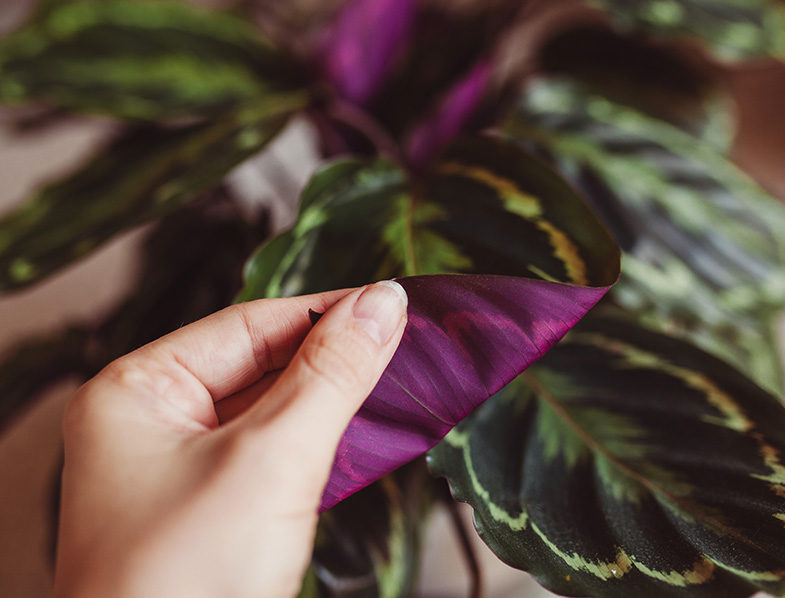
Growing Calathea Medallion
Calathea Medallion is pretty fussy when it comes to lighting conditions. Like most tropical plants, exposure to direct sunlight will cause leaf burn. If you notice any scorching, move the plant away from the window to a more sheltered area. Medallion plants thrive in medium light conditions, similar to their native habitat.
Although Medallions can grow well in north-facing rooms with low light environments, a bit more light will improve their appearance and keep the leaf’s patterns more vibrant. The best location for a Calathea inside the home is in a room with plenty of indirect sunlight.
Make sure you keep your Calathea Medallion away from heaters or radiators. If the air is too hot, the leaves will start to curl. Try to maintain a temperature between 65° and 80° Fahrenheit (18° and 29° Celsius) all year round. If the leaves are fading, your plant is receiving too much direct sunlight. Move it to an area where it can receive only indirect light.
It is worth noting that Calathea Medallion does not appreciate cold drafts and temperature changes, so avoid placing it next to doorways. Because they don’t mind humidity and low-light conditions, Medallions are an excellent choice for bathrooms and kitchens. This makes up for their pretentious nature.
- [TOP PICKS] - Cherry Picked, Locally Sourced, 1000+ house plants available at BubbleBlooms, featuring uniquely created plants from Harmony Foliage
- [COLD-SAFE & ECO] - Winter Protection always included. Secure, eco-friendly packaging ensures flawless delivery.
- [INSTANT GIFTS] - Beautifully packaged, ready-to-impress plant gifts for any occasion.
- [EASY CARE] - Thrive in indirect light; perfect for indoors or outdoors. Expert plant advice anytime.
- [WELLNESS BOOST] - Proven to purify air and reduce stress.
- Striking Foliage & Colorful Patterns: The Calathea Medallion features large, round green leaves with bold, intricate patterns of dark green, light green, and purple, making it a beautiful indoor plant to enhance any home or office décor.
- Perfect for Low-Light Indoor Spaces: Thrives in low to medium indirect light, making it an ideal houseplant for bedrooms, living rooms, or offices that don’t get much sunlight. This makes the Calathea Medallion one of the best low-light indoor plants for your home.
- Air-Purifying Plant: Not only does the Calathea Medallion add vibrant colors to your indoor space, but it also helps to improve air quality by removing toxins from the air, making your home healthier.
- Pet-Friendly & Non-Toxic: Safe for households with pets, the Calathea Medallion is non-toxic to cats and dogs, so you can enjoy this tropical beauty without worrying about your furry friends.
- Easy to Care For: Requires minimal maintenance—keep the soil slightly moist and provide humidity, making it an easy-care houseplant for both beginners and experienced plant enthusiasts.
- REAL PLANTS: Our plant pack contains four Calathea in 4" plant pots. Types may vary. Our decorative plants liven any space as an office plant, desk plant, or as a beloved houseplant. Enjoy live plants for delivery prime — order today, unbox fast.
- AIR PURIFIER: These houseplants live indoor easily, removing toxins from the air. Growing air purifying plants indoor has benefits beyond their cleansing powers — they complement other green plants and low light house plants in your indoor garden.
- PLANT DECOR: Our potted plants live & thrive with minimal care, making indoor plant growing easy. Plant indoor in a plant stand or hanging planter & enjoy the beauty of living plants. Our small house plants are also easy to display as shelf plants.
- OUTDOOR PLANTS: Calathea thrive as an outdoor plant in warm climates. Display as a floor plant to liven up your patio, or plant in your outdoor garden with unique plants & other calathea, like a rattlesnake plant, a zebra plant & a peacock plant.
- NON-TOXIC: If you have furry companions, you’ll be thrilled to learn that calathea is non-toxic to cats and dogs! Your furry friend will not be harmed by rubbing on, eating, or otherwise interacting with them — the only thing that may be compromised is the beauty of your plants, so we recommend displaying your new calathea out of reach of curious, high energy animals.
Last update on 2024-10-08 / Affiliate links / Images from Amazon Product Advertising API
If you notice the mesmerizing leaves of your Calathea Medallion start to brown up or curl, then it could mean that the environment is too dry. To fix this problem, mist it with distilled water regularly, at least once per day. Spray the air around the plant and avoid spraying too close to the leaves. Alternatively, you can use a pebble tray or a humidifier. Ideally, the humidity should be around 50%.
If you want to place Calathea Veitchiana in your garden, on your porch, or on the balcony, make sure the temperatures never drop below 55°F (12°C). Low temperatures can cause permanent damage or even kill the plant. To prevent this, always bring it inside on cold nights. In a south-facing location, make sure your Medallion only gets filtered morning sunlight.
A common problem with tropical plants is the burning of the tips or edges. This could happen due to your tap water. To avoid this, use rainwater, distilled water, or allow the tap water to sit for a day so that the fluoride and chlorine can evaporate. Avoid using shine products on the leaves, but make sure to clean them with a damp cloth when they get dusty.
Planting Calathea Medallion
Calathea Medallion grows best in a porous potting mix with excellent drainage. The ideal soil would be a mixture of potting soil, peat moss, and perlite. You can also add charcoal, orchid bark, vermiculite, or coco coir. The soil should hold enough moisture and nutrients, but also drain well. Avoid soils with too much bark or compost mixed in, as they can cause fungus infestations.
When you buy the plant, check if the soil is too compact and if this is the case loosen it up a bit. Make sure the pots have enough draining holes. To improve drainage, place pebbles along the bottom of the pot. Always empty the tray so that the plant doesn’t sit in soggy soil. Keep in mind that terracotta pots dry out faster than ceramic or plastic.
Calathea Medallion can be fertilized once a month during the growing season, from spring to late summer. During the winter, fertilization should be slowed down or stopped completely. Fertilizer should be moderate and diluted to ¼ of its normal strength. Over-fertilization can cause mineral build-up in the soil which can cause your plant to become leggy, develop root burn, and eventually die. Occasional flushing may be beneficial for Calathea Veitchiana.
To replenish soil nutrients, repot your Calathea every year or every other year. Repotting in spring before the growing season will give the roots more room to grow. Moreover, it can resolve any preexisting soil fungal issues.
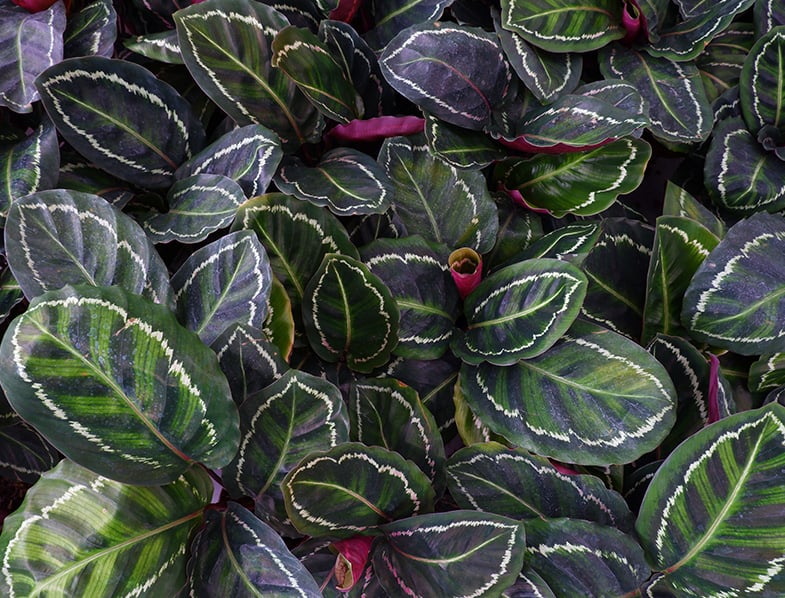
Watering Calathea Medallion
Calathea Medallion is not a drought-tolerant plant, so it requires regular watering. A common mistake when it comes to watering tropical plants is to water on a schedule. Watering too seldom or too often can cause dried leaves, fungus gnats, root rot, and many other problems.
The best way to know when to water is by testing the soil for moisture before watering. Press the potting soil with your finger and check if the top 1” (2.5 cm) is dry. If it’s still moist, hold off watering and check again in a couple of days. If it is dry, thoroughly water the plant and then empty the tray. Most Calatheas, including Medallion, Zebra, and Rattlesnake varieties, it’s better to under-water than over-water.
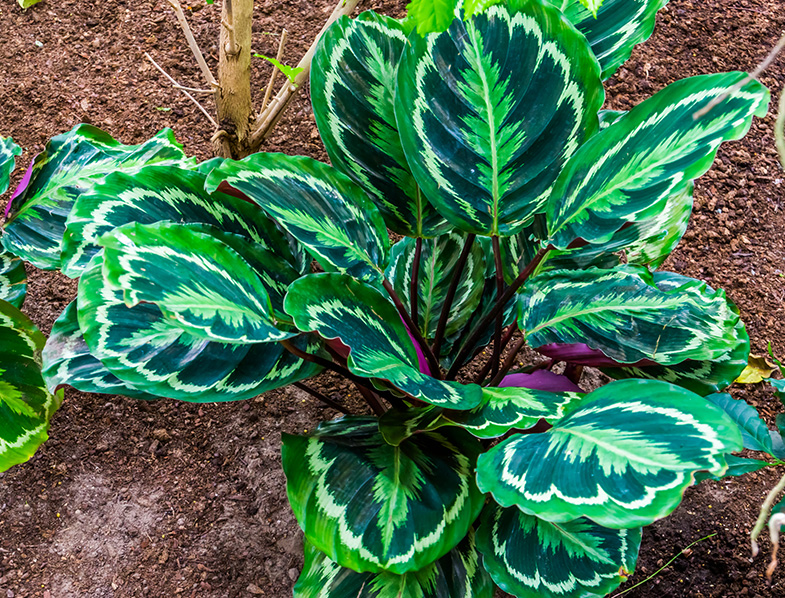
Propagating Calathea Medallion
Unlike plants that can propagate just from cuttings, Calathea Medallion propagation is done by dividing the roots before growing season. To successfully propagate your Medallion, you need to have a healthy, established mother plant, as they don’t like being disturbed. When they are well taken care of, Calatheas shoot out new leaves to expand their beauty. After un-potting the plant, you can see that it is easy to separate it into smaller parts.
After determining which areas you will divide, carefully untangle the roots with your hands. If this is not possible, use a sharp, sterilized knife to cut the tuber. Place the new division in fresh potting soil like the one the mother was in and water thoroughly. The soil needs to remain moist, but not soggy over the next few weeks. Place the new specimen in a dark area, away from strong light. Make sure the humidity is high and mist as needed. After 2 to 4 weeks, you should notice new leaves, indicating that your Calathea Medallion has been successfully propagated.
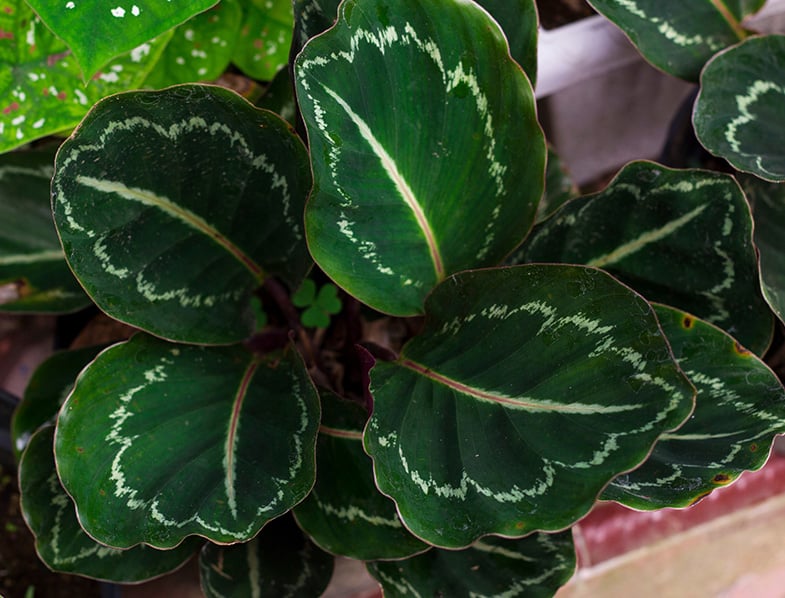
In Conclusion
Although Calathea Medallion is a queen that requires a little bit of extra attention, it’s totally worth it! Gardeners from all over the world love this tropical plant for its stunning emerald green foliage with contrasting white stripes. This beauty even has a day-night circadian rhythm! If you are willing to put in a bit of effort, Calathea Medallion will reward you by bringing life to the most gloomy corners and low-light rooms.
Are you growing Calathea Medallion? Share your experience in the comments below!
Calathea Medallion FAQS
How do you take care of a Calathea Medallion?
- Light: Provide medium light conditions, avoiding direct sunlight to prevent leaf burn.
- Temperature: Keep it between 65° and 80° Fahrenheit (18° to 29° Celsius).
- Watering: Water when the top 1” (2.5 cm) of the soil is dry. Avoid over-watering.
- Humidity: Maintain around 50% humidity. Mist with distilled water or use a humidifier if the environment is too dry.
- Soil: Use a porous potting mix with good drainage, combining potting soil, peat moss, and perlite.
Fertilization: Fertilize once a month during the growing season, using a diluted solution.
Are Calathea Medallions hard to care for?
They require more attention compared to regular indoor plants due to their specific light, temperature, and humidity needs. While not extremely difficult, they can be a bit fussy, especially for inexperienced gardeners.
Does a Calathea Medallion need sun?
Calathea Medallions prefer indirect sunlight. Direct sunlight can scorch their leaves, so they should be placed in a location with plenty of filtered or diffused light.
How much do you water Calathea Medallions?
Water when the top 1” (2.5 cm) of the soil feels dry to the touch. It’s crucial to avoid over-watering; it’s better to under-water than over-water. Always ensure good drainage and empty the tray after watering to prevent the plant from sitting in soggy soil.

